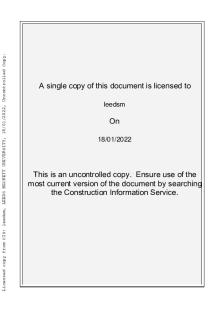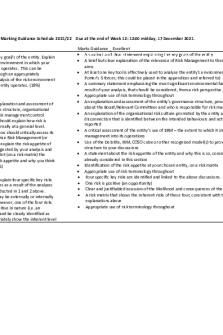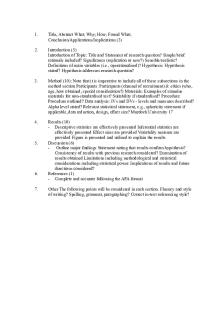Risk Management Marking Guide 2021 Bb version PDF

| Title | Risk Management Marking Guide 2021 Bb version |
|---|---|
| Author | Anonymous User |
| Course | Risk Management |
| Institution | Aston University |
| Pages | 2 |
| File Size | 108.1 KB |
| File Type | |
| Total Downloads | 35 |
| Total Views | 176 |
Summary
risk managmentn essay structure marking guide...
Description
Risk Management Marking Guidance Schedule 2021/22 Due at the end of Week 12: 12:00 midday, 17 December 2021. Requirement 1. Explain the key goal/s of the entity. Explain the business environment in which your chosen entity operates. This can be achieved through an appropriately structured analysis of the risk environment in which the entity operates. (18%)
2. Provide an explanation and assessment of its governance structure, organisational culture and risk management control system. This should explain how risk is managed internally at a general level. Accordingly, you should critically assess its use of Enterprise Risk Management (or not). Further, explain the risk appetite of the entity suggested by your analysis and identify and plot (on a risk matrix) the company’s risk appetite and why you think this is so. (18%) 3. Identify and explain four specific key risks the entity faces as a result of the analyses you have conducted in 1 and 2 above. These risks may be externally or internally generated, however, one of the four risks should be positive in nature (i.e. an opportunity) and be clearly identified as such. Appropriately show the inherent level
Marks Guidance _ Excellent • • A brief but clear explanation of the relevance of Risk Management to their specific strategic aims • At least one key tool is effectively used to analyse the entity’s environment (e.g. PESTLE, Porter’s 5 forces; this could be placed in the appendices and referred to) • A summary statement emphasising the most significant environmental factors identified, as a result of your analysis, that should be considered, from a risk perspective. • Appropriate use of risk terminology throughout • An explanation and assessment of the entity’s governance structure, providing information about the Board/Relevant Committees and who is responsible for risk management • An explanation of the organisational risk culture promoted by the entity and any disconnection that is identified between the intended behaviours and actual behaviours reported • A critical assessment of the entity’s use of ERM – the extent to which it integrates risk management into its operations • Use of the Deloitte, IRM, COSO cube or other recognised model(s) to provide context and structure to your discussions • A statement about the risk appetite of the entity and why this is so, consistent with the areas already considered in this section • Identification of the risk appetite at your chosen entity, on a risk matrix • Appropriate use of risk terminology throughout • Four specific key risks are identified and linked to the above discussions. • One risk is positive (an opportunity) • Clear and justifiable discussion of the likelihood and consequences of the specific risk chosen • A risk matrix that shows the inherent risks of these four, consistent with the individual risk explanations above • Appropriate use of risk terminology throughout
of each risk on a second version of the risk matrix created in part 1 above. (18%) 4. Explain how the entity uses mitigations/controls to move the inherent level of each of the four risks that you identified in part 3, to a new residual level. Clearly show on a third risk matrix whether the subsequent residual level now lies within or beyond, the entity’s risk appetite as a result of the mitigations you describe. (18%) 5. Make a recommendation for better management of one of the key risks that you identified in part 3, incorporating a visual representation of this key risk using a bow-tie analysis diagram. Your bow-tie analysis should clearly show at least two controls currently operating plus your recommended control along with their respective control types. A cost-benefit discussion of your recommended option should also be included. (Please do not choose Brexit or Covid-19). (18%) 1. Layout, grammar and correct referencing (10%)
• • • •
•
• • • • • • • •
Mitigations/controls for each of the four key risks identified in section 3 and consideration of their effectiveness Clear identification of these risk’s “movement” from their inherent to a new residual level as a result of the mitigations/controls identified on a risk matrix Clear indication of how the mitigations/ controls have impacted the residual level of risk relative to the entity’s risk appetite identified in section 2. Appropriate use of risk terminology throughout
A cost-benefit analysis is undertaken of at least the recommendation for better control of the poorly managed risk – this could identify more than one control and play them off against each other. Expectation for reasonable assumptions of costs and benefits and more than one option There is a reasonable and well argued recommendation for the better management of a key risk (identified in section 3) that ties into the above discussion A well-drawn bow-tie analysis with the central risk identified in the middle, at least 4 sources and at least 4 impacts Completion of bow-tie analysis with the controls identified (and labelled by type). Assume there will be 4 controls and 4 control types Appropriate use of risk terminology throughout Correct Harvard in-text referencing and reference list presentation Appropriate use of references and citations Good grammar and logical layout throughout A Report that is digestible by a reader with general business knowledge but a relatively limited knowledge of the principles of Risk Management...
Similar Free PDFs

Essay Marking Guide
- 5 Pages

Risk Management
- 36 Pages

Lecture 4: Risk Management
- 3 Pages

Risk Management Plan Assignment
- 25 Pages

Tim Horton’s Risk Management
- 4 Pages

UKCA Marking Marking of Steel
- 21 Pages

Risk Management Modules
- 24 Pages

Risk Management Guidelines SBP
- 42 Pages

Risk Management During Design
- 28 Pages

CMA P2 Risk Management
- 29 Pages
Popular Institutions
- Tinajero National High School - Annex
- Politeknik Caltex Riau
- Yokohama City University
- SGT University
- University of Al-Qadisiyah
- Divine Word College of Vigan
- Techniek College Rotterdam
- Universidade de Santiago
- Universiti Teknologi MARA Cawangan Johor Kampus Pasir Gudang
- Poltekkes Kemenkes Yogyakarta
- Baguio City National High School
- Colegio san marcos
- preparatoria uno
- Centro de Bachillerato Tecnológico Industrial y de Servicios No. 107
- Dalian Maritime University
- Quang Trung Secondary School
- Colegio Tecnológico en Informática
- Corporación Regional de Educación Superior
- Grupo CEDVA
- Dar Al Uloom University
- Centro de Estudios Preuniversitarios de la Universidad Nacional de Ingeniería
- 上智大学
- Aakash International School, Nuna Majara
- San Felipe Neri Catholic School
- Kang Chiao International School - New Taipei City
- Misamis Occidental National High School
- Institución Educativa Escuela Normal Juan Ladrilleros
- Kolehiyo ng Pantukan
- Batanes State College
- Instituto Continental
- Sekolah Menengah Kejuruan Kesehatan Kaltara (Tarakan)
- Colegio de La Inmaculada Concepcion - Cebu





